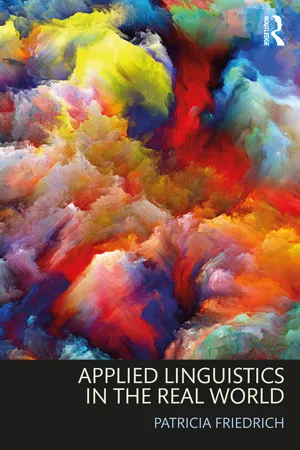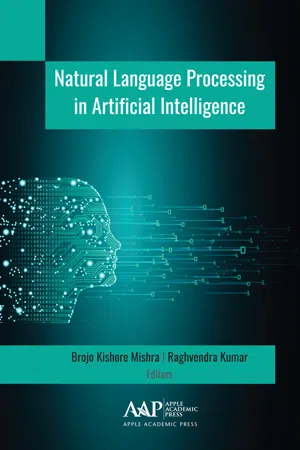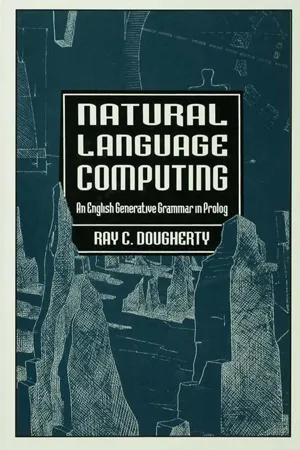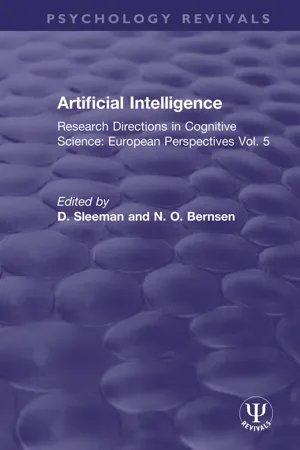Computational Linguistics
Computational Linguistics is a field that combines linguistics and computer science to develop algorithms and models for understanding and processing natural language. It involves tasks such as speech recognition, language translation, and natural language processing. Computational linguists use techniques from machine learning, statistics, and linguistics to analyze and generate human language.
6 Key excerpts on "Computational Linguistics"
- eBook - ePub
The Cognitive Sciences
An Interdisciplinary Approach
- Carolyn P. Sobel, Paul Li(Authors)
- 2013(Publication Date)
- SAGE Publications, Inc(Publisher)
...(But we don’t ignore the fact that probabilities are not certainties, and some of the answers offered by IBM’s supercomputer Watson were absurd!) We also saw that natural language processing, which allowed Watson to comprehend the questions, also employs probabilities, based on the statistical occurrence of the components of human language—necessarily including the insights of linguists. (For example, a very large number of sentences of English begin with the, while very few, if any, begin with checkbook.) Thus, it was not only computer scientists whose expertise played a role in developing Watson; for the machine to understand the questions, posed in English, a human—not a computer—language, computational linguists were needed as well. The field of Computational Linguistics, like that of cognitive science, is interdisciplinary, drawing on the work of researchers in a number of fields. Among these fields are, as you would expect, linguistics, computer science, and artificial intelligence. One direction researchers in Computational Linguistics take is theoretical models (think of Chomsky’s approach to capturing the underlying rules of English as it relates to this project); another direction is the practical uses of modeling human language, such as creating machines that can work with humans using language to communicate. Human language learning may also rely to an extent on computational factors. For example, you have certainly noticed that when you hear someone speaking in a language that you do not speak, what you are hearing seems to you a steady stream of sounds, punctuated from time to time by a falling inflection and a brief pause. It is relatively easy, using these cues, to identify when a sentence has been completed. But how do you separate one word from the next when they all seem to run together? Somehow you learned, when you were very young, to identify individual words in your own language(s) in a stream of speech. Somehow...
- eBook - ePub
- Patricia Friedrich(Author)
- 2019(Publication Date)
- Routledge(Publisher)
...7 Combining corpus linguistics and Computational Linguistics This chapter will do the following 1. Explain the concept of corpus linguistics. 2. Relate the field of Computational Linguistics to corpus linguistics tools. 3. Call for a great partnership between applied linguistics and Computational Linguistics. 4. Exemplify the use of corpora studies across different areas of applied linguistics. 5. Provide ideas for students and scholars who would like to develop projects combining applied linguistics, Computational Linguistics, and corpus analyses. Introduction Imagine these real-world situations: a company would like to know what adjectives its clients are using in social media to describe its products. Or teams of computer scientists and linguists work together in the development of artificial intelligence and language tools, or even, a group of researchers wants to find out whether words from a language they have been trying to revitalize are being spread through Twitter. A linguist wants to investigate large-scale linguistic innovation in social media or wants to find out the geographical location of certain linguistic features (lexical items, for example). Finally, a peace researcher wants to find out what words resonate the most with people doing field work on conflict and peace. What all these situations have in common is the employment of corpus linguistics tools of investigation and the potential use of Computational Linguistics to achieve the goals. According to Weisser (2016, p. 23), “[a] corpus (pl. corpora) is a collection of spoken or written texts to be used for linguistic analysis and based on a specific set of design criteria influenced by its purpose and scope.” In this broad definition, Weisser includes all texts that have been “systematically assembled” even if the collection is modest...
- Brojo Kishore Mishra, Raghvendra Kumar, Brojo Kishore Mishra, Raghvendra Kumar(Authors)
- 2020(Publication Date)
- Apple Academic Press(Publisher)
...As per the mathematician or computer scientist, without algorithm the process of natural language is meaningless and will not to be produce output in proper format. Intelligent Computing is a method, ability to learn knowledge and specific task from the data set across a specified domain or experimental observation. The role of intelligent computing having various computational algorithms like machine learning, deep learning are applied in various parts of NLP like machine translation, sentiment analysis, IR, extraction, etc. 10.1 INTRODUCTION Natural language processing (NLP) is a subfield of computer science, artificial intelligence (AI) concerned with the interactions between computers and human (natural) languages, in particular how to program computers to understand, process, and analyze large amounts of natural language data. Two major things are there, one is natural language understanding (NLU) and natural language generation (NLG). NLP is purely based on grammar-based (rule-based) and statistical-based. In the early days, many language-processing systems were designed by hand-coding a set of rules, e.g., by writing grammars or devising heuristic rules for stemming. However, this is rarely robust to natural language variation. Since the so-called “statistical revolution” [11, 12] in the late 1980s and mid-1990s, much NLP research has relied heavily on machine learning. The machine-learning paradigm calls instead for using statistical inference to automatically learn such rules through the analysis of large corpora of typical real-world examples (a corpus (plural, “corpora”) is a set of documents, possibly with human or computer annotations). Many different classes of machine-learning algorithms (LAs) have been applied to natural-language-processing tasks. These algorithms take as input a large set of “features” that are generated from the input data...
- eBook - ePub
- R.L. Trask, Peter Stockwell(Authors)
- 2007(Publication Date)
- Routledge(Publisher)
...Computational Linguistics The use of computers to perform various tasks involving language. The introduction of digital computers has made possible a number of approaches to descriptive and practical problems of language which could not previously be addressed adequately or at all. One obvious use of computers is to store a corpus of spoken or written texts. Such a machine-readable corpus can be rapidly searched and interrogated in order to obtain such information as the frequency of occurrence of certain words, forms or constructions. In this way we can obtain hard data about real language use which would not otherwise be accessible, and we can further make comparisons between, say, spoken and written English, or between American and British English. This is corpus linguistics, which has had enormous success in recent years in the creation of new grammars based on spoken usage as well as on writing. Concordances are used extensively in the field: a concordance is a computed list of every occurrence of an individual word in the corpus. A corpus can be anything from a small set of texts parsed and tagged right up to multi-million word digitized collections of spoken and written data. Both grammarians and lexicographers today routinely base their grammatical descriptions and their dictionaries on the data extracted from vast corpora. Computational Linguistics has also been influential in machine translation (the development of computer programs which can take a text written in one language and convert it into a different language), speech synthesis and voice recognition (converting written input into an intelligible imitation of human speech), computer-assisted language learning (CALL), and in the stylistic analysis of texts. See also : colligate ; natural-language processing Further reading : Barnbrook 1996; Biber 2006; Crystal 1997; Garside et al. 1997; Mahlberg 2005; McEnery and Wilson 2001; McEnery et al. 2006; O’Grady et al...
- eBook - ePub
Natural Language Computing
An English Generative Grammar in Prolog
- Ray C. Dougherty(Author)
- 2013(Publication Date)
- Psychology Press(Publisher)
...I NTRODUCTION W HAT IS C OMPUTATIONAL L INGUISTICS? The study of generative grammar developed from the confluence of two intellectual traditions: traditional and structuralist grammar, and the study of formal systems. Although there are important precursors, it was not until the mid-1950s that these intellectual currents truly merged, as ideas adapted from the study of formal systems came to be applied to the far more complex systems of natural language in something approaching their actual richness, and in subsequent years, their actual variety, thus making it possible, really for the first time, to give some substance to Humboldt's aphorism that language involves “the infinite use of finite means,” the “finite means” being those that constitute the I-language. Noam Chomsky, 1986 Knowledge of Language Why must we learn a computer language in order to interact with a computer? Why can we not simply type in the information in English sentences and get the machine to respond in English sentences? What difficulties block the construction of an English-French-German translation program? The goal of this book is to make explicit some of the main problems facing any project to develop a computing machine that can read and write in English or that can translate among English, German, and French...
- eBook - ePub
Artificial Intelligence
Research Directions in Cognitive Science: European Perspectives Vol. 5
- D. Sleeman, N. O. Bernsen, D. Sleeman, N. O. Bernsen(Authors)
- 2019(Publication Date)
- Routledge(Publisher)
...CHAPTER 2 LANGUAGE UNDERSTANDING BY COMPUTER: DEVELOPMENTS ON THE THEORETICAL SIDE Harry Bunt ITK, Institute for Language Technology and Al, Tilburg, The Netherlands 1. INTRODUCTION This paper consists of three parts. In the first part I discuss the notion of language understanding and how it relates to Artificial Intelligence. In the second part I review some of the more important recent work on the theoretical side in the design of computer systems intended to understand natural language. In the third part I present a view on directions in the computational modelling of language understanding that seem most important for the near future. 2. UNDERSTANDING LANGUAGE 2.1 Human and Artificial Language Understanding Until two decades ago, the only type of language understander was the human understander; language understanding was synonymous with human language understanding, and the study of language understanding was part of cognitive psychology and psycholinguistics. In the sixties, Chomsky pointed out the theoretical importance of the fact that humans are able to understand infinite varieties of natural-language expressions in spite of finite information-processing resources; the implication being that meaning is encoded in natural language in systematic ways, describable by finite sets of grammatical rules and principles in combination with lexical knowledge. Since computers are able to store and effectively apply lexicons and large sets of rules in complex tasks, the human understander is no longer the only conceivable kind of language understander. When undertaking the design of a language understanding system, we have to face the question of what it is exactly that has to happen inside the machine in order to speak of "understanding". In other words, what exactly should be the result of an understanding process...





